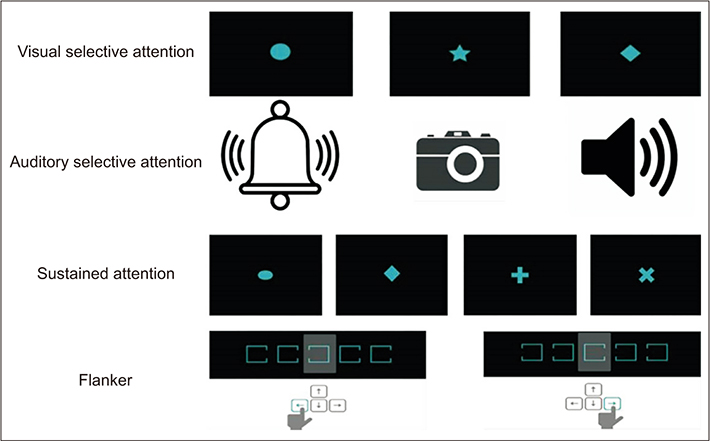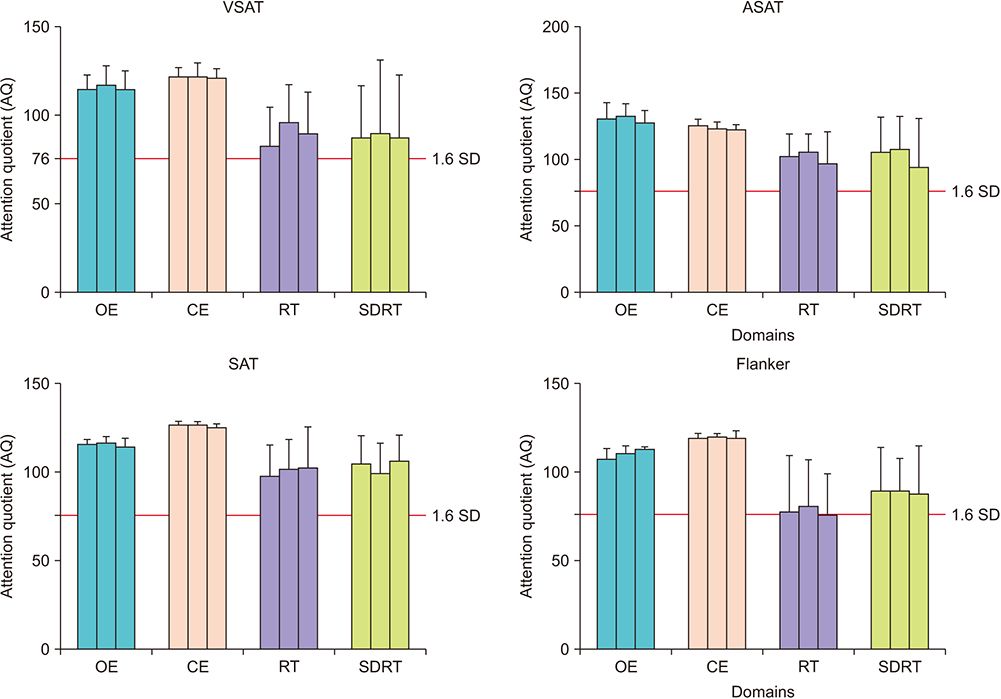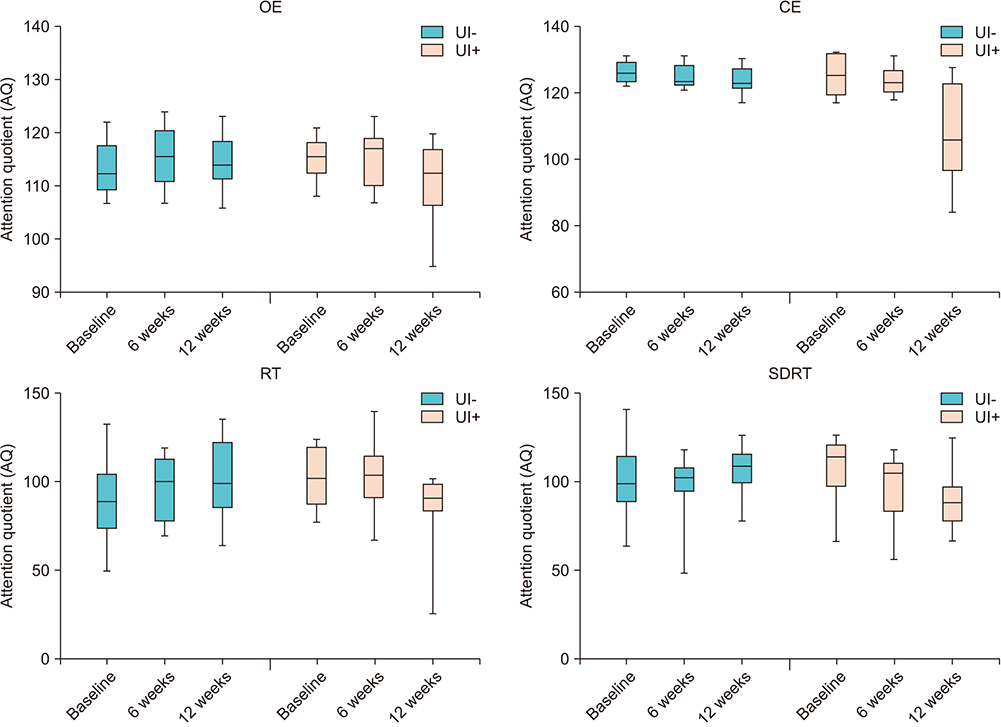Investig Clin Urol.
2020 Mar;61(2):207-215. 10.4111/icu.2020.61.2.207.
Changes in attention variables in those who treated with anticholinergic agents for nonmonosymptomatic enuresis
- Affiliations
-
- 1Department of Urology, Seoul National University College of Medicine, Seoul, Korea. urodori9@snu.ac.kr
- KMID: 2471077
- DOI: http://doi.org/10.4111/icu.2020.61.2.207
Abstract
- PURPOSE
Brain dysfunction related to areas regarding attention and arousal may occur not only in patients with attention-deficit/hyperactivity disorder (ADHD) but also in patients with enuresis and daytime symptoms. This study aimed to investigate changes in computerized comprehensive attention tests (CATs), a psychometric test for ADHD when patients with nonmonosymptomatic enuresis (NME) were treated with anticholinergic agents.
MATERIALS AND METHODS
Thirty patients with NME featuring overactive bladder were prospectively enrolled. They were treated with 5 mg of solifenacin to control daytime symptoms. Using CATs, patients were evaluated during 12 weeks of treatment. Four subtests of attention (visual and auditory selective attention, sustained attention, and flanker tests) were measured. For each subtest, four domains (omission error, commission error, response time [RT], and standard deviation of RT) were assessed.
RESULTS
Only one domain of the flanker test was in the deficient range at baseline. The presence of urge incontinence affected follow-up results on the sustained attention tests. Treatment with anticholinergic agents did not significantly affect attention variables but changes in several variables were correlated with bladder symptoms and enuresis.
CONCLUSIONS
Minimal baseline defects in attention function were seen in patients with NME. Follow-up results for some attention variables were affected by daytime symptoms and enuresis. These results suggest that altered brain function in enuretic patients influences improvement in both attention and bladder function.
MeSH Terms
Figure
Reference
-
1. Nevéus T. Nocturnal enuresis-theoretic background and practical guidelines. Pediatr Nephrol. 2011; 26:1207–1214.
Article2. Xiang B, Biji S, Liu JX, Chu WC, Yeung DK, Yeung CK. Functional brainstem changes in response to bladder function alteration elicited by surgical reduction in bladder capacity: a functional magnetic resonance imaging study. J Urol. 2010; 184:2186–2191.
Article3. Yeung CK, Diao M, Sreedhar B. Cortical arousal in children with severe enuresis. N Engl J Med. 2008; 358:2414–2415.
Article4. Nevéus T. Pathogenesis of enuresis: towards a new understanding. Int J Urol. 2017; 24:174–182.
Article5. Ornitz EM, Russell AT, Hanna GL, Gabikian P, Gehricke JG, Song D, et al. Prepulse inhibition of startle and the neurobiology of primary nocturnal enuresis. Biol Psychiatry. 1999; 45:1455–1466.
Article6. Von Gontard A, Schmelzer D, Seifen S, Pukrop R. Central nervous system involvement in nocturnal enuresis: evidence of general neuromotor delay and specific brainstem dysfunction. J Urol. 2001; 166:2448–2451.
Article7. Bush G. Cingulate, frontal, and parietal cortical dysfunction in attention-deficit/hyperactivity disorder. Biol Psychiatry. 2011; 69:1160–1167.
Article8. von Gontard A, Equit M. Comorbidity of ADHD and incontinence in children. Eur Child Adolesc Psychiatry. 2015; 24:127–140.
Article9. Eggert P, Freischmidt S, Bismarck PV, Schulz-Jürgensen S. Differentiation of subgroups of monosymptomatic enuresis according to prepulse inhibition of the startle reflex. Acta Paediatr. 2012; 101:e304–e308.
Article10. Hawk LW Jr, Yartz AR, Pelham WE Jr, Lock TM. The effects of methylphenidate on prepulse inhibition during attended and ignored prestimuli among boys with attention-deficit hyperactivity disorder. Psychopharmacology (Berl). 2003; 165:118–127.
Article11. Lei D, Ma J, Du X, Shen G, Tian M, Li G. Altered brain activation during response inhibition in children with primary nocturnal enuresis: an fMRI study. Hum Brain Mapp. 2012; 33:2913–2919.
Article12. Golding J, Pembrey M, Jones R. ALSPAC Study Team. ALSPAC--the Avon Longitudinal Study of Parents and Children. I. Study methodology. Paediatr Perinat Epidemiol. 2001; 15:74–87.13. von Gontard A, Moritz AM, Thome-Granz S, Freitag C. Association of attention deficit and elimination disorders at school entry: a population based study. J Urol. 2011; 186:2027–2032.
Article14. Butler R, Heron J. Alspac Study Team. Exploring the differences between mono- and polysymptomatic nocturnal enuresis. Scand J Urol Nephrol. 2006; 40:313–319.
Article15. Kuhn S, Natale N, Siemer S, Stoeckle M, von Gontard A. Clinical differences in daytime wetting subtypes: urge incontinence and postponed voiding. J Urol. 2009; 182:4 Suppl. 1967–1972.
Article16. Zink S, Freitag CM, von Gontard A. Behavioral comorbidity differs in subtypes of enuresis and urinary incontinence. J Urol. 2008; 179:295–298. discussion 8.
Article17. Giramonti KM, Kogan BA, Halpern LF. The effects of anticholinergic drugs on attention span and short-term memory skills in children. Neurourol Urodyn. 2008; 27:315–318.
Article18. Kay G, Crook T, Rekeda L, Lima R, Ebinger U, Arguinzoniz M, et al. Differential effects of the antimuscarinic agents darifenacin and oxybutynin ER on memory in older subjects. Eur Urol. 2006; 50:317–326.
Article19. Sommer BR, O'Hara R, Askari N, Kraemer HC, Kennedy WA 2nd. The effect of oxybutynin treatment on cognition in children with diurnal incontinence. J Urol. 2005; 173:2125–2127.
Article20. Kim SJ, Lee YJ, Cho SJ, Cho IH, Lim W, Lim W. Relationship between weekend catch-up sleep and poor performance on attention tasks in Korean adolescents. Arch Pediatr Adolesc Med. 2011; 165:806–812.
Article21. Kim SJ, Lee YJ, Jang JH, Lim W, Cho IH, Cho SJ. The relationship between psychotic-like experiences and attention deficits in adolescents. J Psychiatr Res. 2012; 46:1354–1358.
Article22. Elia J, Takeda T, Deberardinis R, Burke J, Accardo J, Ambrosini PJ, et al. Nocturnal enuresis: a suggestive endophenotype marker for a subgroup of inattentive attention-deficit/hyperactivity disorder. J Pediatr. 2009; 155:239–244.e5.
Article23. Yang TK, Huang KH, Chen SC, Chang HC, Yang HJ, Guo YJ. Correlation between clinical manifestations of nocturnal enuresis and attentional performance in children with attention deficit hyperactivity disorder (ADHD). J Formos Med Assoc. 2013; 112:41–47.
Article24. Van Herzeele C, Dhondt K, Roels SP, Raes A, Groen LA, Hoebeke P, et al. Periodic limb movements during sleep are associated with a lower quality of life in children with monosymptomatic nocturnal enuresis. Eur J Pediatr. 2015; 174:897–902.
Article25. Van Herzeele C, Dhondt K, Roels SP, Raes A, Groen LA, Hoebeke P, et al. Neuropsychological functioning related to specific characteristics of nocturnal enuresis. J Pediatr Urol. 2015; 11:208.e1–208.e6.
Article26. Fonseca EG, Bordallo AP, Garcia PK, Munhoz C, Silva CP. Lower urinary tract symptoms in enuretic and nonenuretic children. J Urol. 2009; 182:4 Suppl. 1978–1983.
Article27. Rittig N, Hagstroem S, Mahler B, Kamperis K, Siggaard C, Mikkelsen MM, et al. Outcome of a standardized approach to childhood urinary symptoms-long-term follow-up of 720 patients. Neurourol Urodyn. 2014; 33:475–481.
Article28. Hochman EY, Vaidya AR, Fellows LK. Evidence for a role for the dorsal anterior cingulate cortex in disengaging from an incorrect action. PLoS One. 2014; 9:e101126.
Article29. Chapple CR, Cardozo L, Steers WD, Govier FE. Solifenacin significantly improves all symptoms of overactive bladder syndrome. Int J Clin Pract. 2006; 60:959–966.
Article30. Newgreen D, Bosman B, Hollestein-Havelaar A, Dahler E, Besuyen R, Sawyer W, et al. Solifenacin in children and adolescents with overactive bladder: results of a phase 3 randomised clinical trial. Eur Urol. 2017; 71:483–490.
Article
- Full Text Links
- Actions
-
Cited
- CITED
-
- Close
- Share
- Similar articles
-
- Treatment of lower urinary tract dysfunction facilitates awakening and affects the cure rate in patients with nonmonosymptomatic enuresis
- Endoscopic Botulinum Toxin Injection for Refractory Enuresis Based on Urodynamic Assessment
- Efficacy of Salvage Interferential Electrical Stimulation Therapy in Patients With Medication-Refractory Enuresis: A Pilot Study
- Time Course of Treatment for Primary Enuresis With Overactive Bladder
- The Effect of Imipramine and Desmopressin for the Treatment of Enuresis in Attention Deficit Hyperactivity Disorder Children




